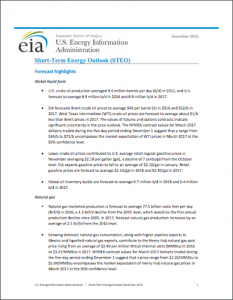Full Title: U.S. Energy Information Administration Short Term Energy Outlook 2017
Author(s):
Publisher(s): U.S. Energy Information Administration
Publication Date: January 1, 2017
Full Text: Download Resource
Description (excerpt):
Forcast Highlights
- This edition of the Short-Term Energy Outlook is the first to include forecasts for 2018.
- Benchmark North Sea Brent crude oil spot prices averaged $53/barrel (b) in December, a
$9/b increase from November. This was the first month since July 2015 in which Brent spot
prices averaged more than $50/b. - Brent crude oil prices are forecast to average $53/b in 2017 and $56/b in 2018. West Texas
Intermediate (WTI) crude oil prices are forecast to average $1/b less than Brent in both 2017
and 2018. The current values of futures and options contracts suggest high uncertainty in
the price outlook. For example, EIA’s forecast for the average WTI price in December 2017
of $53/b should be considered in the context of NYMEX contract values for December 2017
delivery. Contracts traded during the five-day period ending January 5 suggest the market
expects WTI prices could range from $35/b to $93/b (at the 95% confidence interval) in
December 2017. - U.S. regular gasoline retail prices are expected to increase from an average of $2.25/gallon
(gal) in December to $2.31/gal in the first quarter of 2017. U.S. regular gasoline retail prices
are forecast to average $2.38/gal in 2017 and $2.41/gal in 2018. - U.S. crude oil production averaged an estimated 8.9 million barrels per day (b/d) in 2016
and is forecast to average 9.0 million b/d in 2017 and 9.3 million b/d in 2018. The forecast
increases in production largely reflect increases in federal offshore Gulf of Mexico
production. Rising tight oil production, which results from increases in drilling activity, rig
efficiency, and well-level productivity, also contributes to forecast U.S. production growth.
